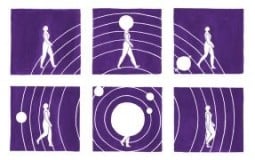Magnetic atoms, such as titanium atoms, if they are close enough together, can talk through a quantum property called spin. You can see this as a compass needle of an atom that can point up or down and that feels what compass needles (or spins) of neighboring atoms happens; if the compass needle of one atom rotates, the needle of the other will also rotate. If these spins spin together, then they are in conversation.
A clumsy method
In the study, the physicists place two titanium atoms a nanometer – a millionth of a millimeter – apart so that they feel each other’s spin. With a short electric pulse, the physicists then flip one of the spins at lightning speed. This push causes the spins to oscillate together; first one points up and the other down, then vice versa, and so on. With a second, weaker current pulse, the researchers measure which way the spins point during the oscillation. For the first time, they have been able to accurately follow spin oscillations, and thus the conversation between two atoms.
The use of an electric pulse, in which an electron collides with the titanium atom and flips the spin, is daring. Radio signals are used in other experiments, but that was too slow for this study. The electric shock was an experiment, says Otte. “It’s a more clunky method. We feared it would disrupt the fragile quantum bond between the two atoms, preventing them from oscillating together. But to our surprise, that didn’t happen.” An additional discovery is therefore that you can reverse the spin of an atom with relatively much force, without disrupting the entire system. This offers perspectives for future research.
The atoms turned out to flip back and forth together in a dozen nanoseconds (billionths of a second). How atoms oscillate together depends on the type of atom, their spacing, and how they are arranged. Otte: “The material determines what the atoms will discuss, we can only give a push to start the conversation.”
I want to get to more than fifty atoms as soon as possible
Sander Otte TU Delft
For two atoms, the spin oscillations are simple and predictable. “We overheard a conversation, but it was a very boring conversation.” If you try to listen to a conversation between three or more atoms, the oscillations they are talking with become more difficult to predict. “You can calculate that with a laptop up to about twenty atoms,” says Otte. “But with fifty or more atoms, even the best computers in the world don’t have enough computing power to calculate exactly what is happening.” A few grams of a material quickly consists of trillions of atoms. Those group conversations are completely unpredictable.
The next step is therefore to expand this ‘eavesdropping system’ to more atoms and combinations of different atoms. “I want to get to more than fifty atoms as soon as possible,” says Otte. “Then the conversation is no longer predictable and it becomes really interesting.”
Then you can, for example, study the behavior of superconducting materials, through which electric current moves without resistance at low temperatures. How this works at higher temperatures, in more complex materials, is not well understood at the atomic level. “The complete understanding of spinning behavior in materials that is required for this is still a long way off,” admits Otte. “But by listening to conversations between more and more atoms, we gradually gain more insight into how nature behaves.”













